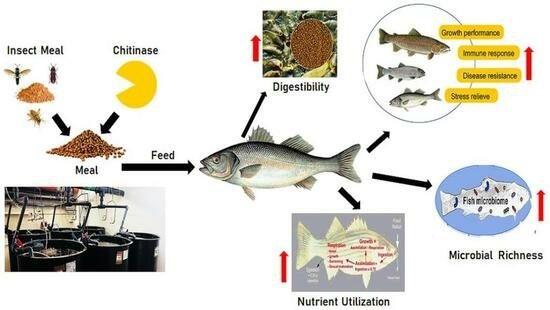
The thriving aquaculture industry faces a critical challenge: finding sustainable alternatives to traditional fishmeal in fish and crustacean feeds.
In this context, insect meals emerge as a promising solution, rich in high-quality proteins and an ideal amino acid profile. However, these nutritional powerhouses harbor a hidden secret: chitin, a resilient fiber found in their exoskeletons.
While its derivative, chitosan, offers interesting benefits such as promoting fish growth, immunity, and disease resistance, chitin itself may pose a challenge to the digestibility of some fish species. This complex combination of opportunities and challenges makes incorporating insect meals into aquaculture feeds a daunting task.
In this regard, a team of scientists from the University of Insubria, the National Research Council, and the Universitaria Professionale della Svizzera Italiana published a scientific review providing a detailed analysis of the applications, benefits, and challenges of using chitinase in aquaculture to harness the potential of insect meal. They emphasize the enzyme’s role in improving feed digestibility, disease control, and environmental sustainability.
The Potential of Insect Meals
Over the past decade, insect meals have gained interest from researchers and feed producers for aquaculture as a sustainable source to partially or fully replace fishmeal in aquaculture feeds.
Scientific literature has reported numerous trials conducted by different research groups highlighting the potential of insect meals as a sustainable and effective alternative to fishmeal in aquaculture feed formulations.
Experiences with the black soldier fly (Hermetia illucens), yellow mealworm (Tenebrio molitor), housefly (Musca domestica), house cricket (Acheta domesticus), among other species, have been reported with varying results depending on the inclusion level and target species.
However, the presence of chitin in insects may reduce the digestibility of aquaculture feeds since most fish cannot digest and absorb it.
The Role of Chitinase
Fortunately, science has a potential solution: chitinase, an enzyme that acts as a molecular locksmith, breaking down the tough chains of chitin.
Chitinase enzymatically hydrolyzes chitin into digestible carbohydrates that can be used in fish feeds. This means they can be more easily absorbed in the animal’s digestive tract, contributing to overall nutrient absorption.
According to the study, chitinase offers a host of benefits for fish:
- Improved Digestibility: By unlocking the goodness of insect meals, chitinase helps fish absorb more nutrients, leading to better growth and health.
- Enhanced Disease Control: Chitinase degradation products may have antimicrobial properties, potentially offering an additional layer of protection against fish diseases.
- Sustainable Solution: The use of insect meals reduces dependence on wild fish for aquaculture feeds, promoting a more environmentally friendly aquaculture industry.
Unleashing the Full Potential
While research paints a promising picture, the story of chitinase is still unfolding. Here are some key challenges and intriguing possibilities:
Enzyme Specificity: Different types of chitinase target specific chitin linkages. It is crucial to find the right “key” for each insect food species.
Optimization Strategies: Research is underway to refine production and application methods of chitinase for maximum efficiency and cost-effectiveness.
Sustainable Insect Production: Ensuring a reliable and sustainable supply of high-quality insect meal is key to long-term success.
Key Conclusions
The researchers conclude that understanding the interaction between insect meals, chitin, and chitosan is crucial. “The potential benefits, including better growth and increased disease resistance, should be weighed against the challenges associated with feed digestibility in certain fish species,” they concluded.
The scientific review provides valuable information for researchers, professionals, and stakeholders on the evolving landscape of insect meals and their applications.
By working together, scientists, aquaculturists, and consumers can unlock the hidden powers of insects and chitinase, ensuring a healthy and sustainable future for aquaculture and the delicious seafood we love.
The study was funded by the IBISBA-IT MICROSPICHI project (Modulation of the intestinal MICRObiota in SEABASS fed with insect meal supplemented with CHItinase) and the ON Foods project–Research and innovation network on food and nutrition Sustainability, Safety and Security—Working ON Foods, financed under the National Recovery and Resilience Plan (NRRP) of the Italian Ministry of University and Research, subsidized by the European Union—Next Generation EU.
Reference (open access):
Hasan, Imam, Francesco Gai, Simona Cirrincione, Simona Rimoldi, Giulio Saroglia, and Genciana Terova. 2023. “Chitinase and Insect Meal in Aquaculture Nutrition: A Comprehensive Overview of the Latest Achievements” Fishes 8, no. 12: 607. https://doi.org/10.3390/fishes8120607″

